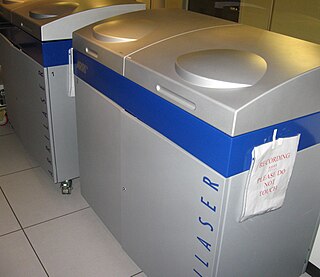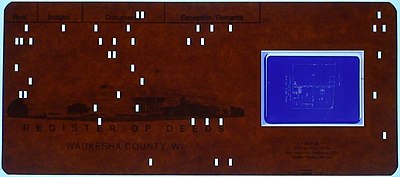
In computing, a printer is a peripheral machine which makes a durable representation of graphics or text, usually on paper. While most output is human-readable, bar code printers are an example of an expanded use for printers. Different types of printers include 3D printers, inkjet printers, laser printers, and thermal printers.

A punched card is a piece of card stock that stores digital data using punched holes. Punched cards were once common in data processing and the control of automated machines.

A digital camera, also called a digicam, is a camera that captures photographs in digital memory. Most cameras produced today are digital, largely replacing those that capture images on photographic film or film stock. Digital cameras are now widely incorporated into mobile devices like smartphones with the same or more capabilities and features of dedicated cameras. High-end, high-definition dedicated cameras are still commonly used by professionals and those who desire to take higher-quality photographs.
Digital intermediate (DI) is a motion picture finishing process which classically involves digitizing a motion picture and manipulating the color and other image characteristics.

A film recorder is a graphical output device for transferring images to photographic film from a digital source. In a typical film recorder, an image is passed from a host computer to a mechanism to expose film through a variety of methods, historically by direct photography of a high-resolution cathode ray tube (CRT) display. The exposed film can then be developed using conventional developing techniques, and displayed with a slide or motion picture projector. The use of film recorders predates the current use of digital projectors, which eliminate the time and cost involved in the intermediate step of transferring computer images to film stock, instead directly displaying the image signal from a computer. Motion picture film scanners are the opposite of film recorders, copying content from film stock to a computer system. Film recorders can be thought of as modern versions of Kinescopes.

Starting at the end of the nineteenth century, well before the advent of electronic computers, data processing was performed using electromechanical machines collectively referred to as unit record equipment, electric accounting machines (EAM) or tabulating machines. Unit record machines came to be as ubiquitous in industry and government in the first two-thirds of the twentieth century as computers became in the last third. They allowed large volume, sophisticated data-processing tasks to be accomplished before electronic computers were invented and while they were still in their infancy. This data processing was accomplished by processing punched cards through various unit record machines in a carefully choreographed progression. This progression, or flow, from machine to machine was often planned and documented with detailed flowcharts that used standardized symbols for documents and the various machine functions. All but the earliest machines had high-speed mechanical feeders to process cards at rates from around 100 to 2,000 per minute, sensing punched holes with mechanical, electrical, or, later, optical sensors. The operation of many machines was directed by the use of a removable plugboard, control panel, or connection box. Initially all machines were manual or electromechanical. The first use of an electronic component was in 1937 when a photocell was used in a Social Security bill-feed machine. Electronic components were used on other machines beginning in the late 1940s.

A keypunch is a device for precisely punching holes into stiff paper cards at specific locations as determined by keys struck by a human operator. Other devices included here for that same function include the gang punch, the pantograph punch, and the stamp. The term was also used for similar machines used by humans to transcribe data onto punched tape media.

The tabulating machine was an electromechanical machine designed to assist in summarizing information stored on punched cards. Invented by Herman Hollerith, the machine was developed to help process data for the 1890 U.S. Census. Later models were widely used for business applications such as accounting and inventory control. It spawned a class of machines, known as unit record equipment, and the data processing industry.

Microprinting is the production of recognizable patterns or characters in a printed medium at a scale that typically requires magnification to read with the naked eye. To the unaided eye, the text may appear as a solid line. Attempts to reproduce by methods of photocopy, image scanning, or pantograph typically translate as a dotted or solid line, unless the reproduction method can identify and recreate patterns to such scale. Microprint is predominantly used as an anti-counterfeiting technique, due to its inability to be easily reproduced by widespread digital methods.

A film scanner is a device made for scanning photographic film directly into a computer without the use of any intermediate printmaking. It provides several benefits over using a flatbed scanner to scan in a print of any size: the photographer has direct control over cropping and aspect ratio from the original, unmolested image on film; and many film scanners have special software or hardware that removes scratches and film grain and improves color reproduction from film.

A microform is a scaled-down reproduction of a document, typically either photographic film or paper, made for the purposes of transmission, storage, reading, and printing. Microform images are commonly reduced to about 4% or 1⁄25 of the original document size. For special purposes, greater optical reductions may be used.

Edge-notched cards or edge-punched cards are a system used to store a small amount of binary or logical data on paper index cards, encoded via the presence or absence of notches in the edges of the cards. The notches allow efficient sorting of a large number of cards in a paper-based database, as well as the selection of specific cards matching multiple desired criteria.
Paper data storage refers to the use of paper as a data storage device. This includes writing, illustrating, and the use of data that can be interpreted by a machine or is the result of the functioning of a machine. A defining feature of paper data storage is the ability of humans to produce it with only simple tools and interpret it visually.

"As We May Think" is a 1945 essay by Vannevar Bush which has been described as visionary and influential, anticipating many aspects of information society. It was first published in The Atlantic in July 1945 and republished in an abridged version in September 1945—before and after the atomic bombings of Hiroshima and Nagasaki. Bush expresses his concern for the direction of scientific efforts toward destruction, rather than understanding, and explicates a desire for a sort of collective memory machine with his concept of the memex that would make knowledge more accessible, believing that it would help fix these problems. Through this machine, Bush hoped to transform an information explosion into a knowledge explosion.

The National Mine Map Repository (NMMR) is part of the United States Department of the Interior (DOI), Office of Surface Mining Reclamation and Enforcement. The NMMR resides in the Pittsburgh suburb of Green Tree, Pennsylvania, and collects and maintains mine map information and images for the entire country, including data and maps of coal mines in the anthracite coal region of northeastern Pennsylvania. The Green Tree facility provides and stores, digitally and in microfilm, over 182,000 maps of abandoned mines. This repository contains maps of mine workings from the 1790s to the present day. It serves as a point of reference for mine maps and other information for both surface and underground mines throughout the United States. It also serves as a location to retrieve mine maps in an emergency. The NMMR provides services ranging from retrieving mine related data for economic analysis to assessing the potential risk associated with underground mining. Through analysis of mine maps and related information, the repository assists private and public sectors in industrial and commercial development, highway construction, and the preservation of public health, safety, and welfare. In addition, they collect, reproduce, and maintain a national inventory of mine maps and supporting documentation for private and public interests.
A microfilm reader is a device used in projecting and magnifying images stored in microform to readable proportions. Microform includes flat film, microfilm, aperture cards, microfiche, and ultra fiche. Using open reels or cassettes, microfilm is often used as a way to store many documents in a small space. It has become increasingly prevalent in the development of films, as well as storage of archived newspapers. With the invention of microfilm, microfilm readers soon developed. With the increasing popularity of computers, microform has decreased in use. However, many library archives still remain in microform.

A superimposed code such as Zatocoding is a kind of hash code that was popular in marginal punched-card systems.
A ballot marking device (BMD) or vote recorder is a type of voting machine used by voters to record votes on physical ballots. In general, ballot marking devices neither store nor tabulate ballots, but only allow the voter to record votes on ballots that are then stored and tabulated elsewhere.

FOSDIC is a family of optical scanners for converting data on microfilm to computer-readable magnetic tape. FOSDIC was designed and built by the United States National Bureau of Standards for use by the United States Census Bureau and other government agencies.

IBM manufactured and sold microfilm products from 1963 till 1969. It is an example of IBM attempting to enter an established market on the basis of a significant technical breakthrough.
















